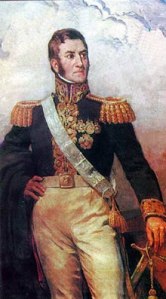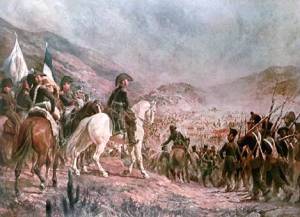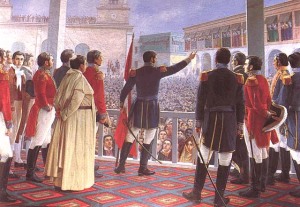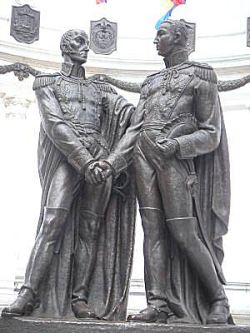Today in the Americas, Jose Francisco de San Martin
 Today, in 1778 (231 years ago) Jose Francisco de San Martín was born Yapeyú, Argentina.
Today, in 1778 (231 years ago) Jose Francisco de San Martín was born Yapeyú, Argentina.
Like many who would come to wrest power from Spain into their hands at the turn of the nineteenth century, San Martín was born in South America and educated abroad in Spain and England. He even went so far as to fight in several battles against Napoleon on the Spanish side in 1808. It was after this that San Martín wished to make his services known for South American independence movements back home. In 1812, he sailed to Buenos Aires on the George Canning.
San Martín was a military man and, upon arrival in Argentina, was accepted into military establishment. He taught his troops modern warfare techniques. In October, the Ejército del Norte, commanded by Manuel Belgrano landed in Buenos Aires. San Martín got the better of this deal, as the regiment dissolved the ruling triumvirate and replaced it with new members loyal to their cause. San Martín was promoted to Colonel.
This time coincided with the decline of Spanish presence in the Americas. After sacking Montevideo, now in Uruguay, which was held by Spanish loyalists, Spain sent troops to try to gain back favor in South America. What resulted was the first skirmish in San Martín’s South American career, at San Lorezno (1813). It was here that San Martín and his forces protected the Paraná River shore from Spanish fleets. San Martín almost saw death at this battle, but survived and was promoted to General.
Massive resistance was occurring now throughout the continent. San Martín was trying to find a way to attack Peru through Chile. In moves recognizable today, San Martín used espionage,  disinformation and other tactics to gain the upper hand in his advance on Lima, the capital of the Vice Royalty of Peru. By 1815, as governor of Cuyo, he assembled his “Army of the Andes,” which prior to his trek across the Andes mountains Ahad been somewhat of joke as many were skeptical about his ability to sustain an army on a mission like that and if a mission to Peru was even necessary. But by August 1816, his mission was receiving full support of those in power.
disinformation and other tactics to gain the upper hand in his advance on Lima, the capital of the Vice Royalty of Peru. By 1815, as governor of Cuyo, he assembled his “Army of the Andes,” which prior to his trek across the Andes mountains Ahad been somewhat of joke as many were skeptical about his ability to sustain an army on a mission like that and if a mission to Peru was even necessary. But by August 1816, his mission was receiving full support of those in power.
It took them 21 days for two columns to cross the Andes.
On February 10, 1817, the Battle of Chacabuco took place in the Aconcagua valley in Chile. San Martín, battling arthritis, commanded the battle with a superior advantage to Spanish soldiers. The battle was more of a bloodbath – as the royalists suffered 500 dead and 600 taken prisoner; San Martín lost only 12 with 100 wounded.
The Army of the Andes has attained glory and can report: In twenty-four days we have completed the campaign, passed through the highest mountain range on the globe, defeated the tyrants and given freedom to Chile.
On February 14, San Martín entered Santiago and by the 18th was elected Governor of Chile. He immediately resigned, the position going to Bernardo O’Higgins, who become Director Supremo del Estado de Chile. The armies of Chile and Argentina combined into the United Army – San Martín as general of the whole Army.
Other battles occurred, such as the Battle of Cancha Rayada on March 19, that were Spanish and royalist response to San Martín’s strength in Chile. The Battle of Cancha Rayada is important because San Martín and Bernardo O’Higgin’s were forced into retreat from south-central Chile, the town of Talca. They lost a lot of men in that battle – rumors of San Martín and O’Higgin’s death spread across Chile. Over 150 were killed, over 200 taken prisoner and even more deserted before the retreat was ordered by San Martín. This was the only loss he would suffer.
Less than two weeks later, on April 4, 1818, San Martín would redeem himself in the Maipú plains. He split his United Army into thirds as he watched General Osorio, the royalist general who oversaw the Canacha Rayada adventure, taking defensive positions. According to John Thomond O’Brien, San Martín, seeing Osorio’s disposition of the forces, exclaimed:
Osorio is clumsier than I thought. Today’s triumph is ours. The sun as witness!

San Martín triumphed. The royalist suffered 2,000 dead, 3,000 prisoner, and lost all of its artillery. Again, the United Army suffered on 100 casualties. Spanish control of Chile was thus effectively ended.
After several attempts, one due to health reasons and the other due to a separate military defeat, of handing in his resignation of general of the United Army, San Martín’s attempts were denied. It would be in 1820, when the Chilean Navy would land in Peru, the goal of San Martín all along. He sent his famous message to the people of Peru:
My announcement is not that of a conqueror that tries to create a new enslavement. I cannot help but be an accidental instrument of justice and agent of destiny. The outcome of victory will make Peru’s capital see for the first time their sons united, freely choosing their government and emerging into the face of earth among the rank of nations

In Peru, there were not the battles of Argentina and Chile. San Martín emphasized diplomacy. Peru would eventually be his – as he occupied Lima on July 12, 1821. Then, one of the most interesting aspects of the South American wars for independence coalesced in Guayaquil a few weeks later, on July 26.
Borges, in his story “Guayaquil” evokes the memories of this turning point in South American history. It is here that Simón Bolívar and San Martín met, as their two strands of independence met in Peru. The two discussed further expulsions of Spaniards, but the notes were not kept for this occasion, and no one knows why San Martín gave his entire armed forces over to Bolívar, only the gods of history know that much.
San Martín left for Europe in 1824 after Guayaquil. He never went back to South America. He died in August of 1850 in Boulogne-sur-Mer, France. His remains currently lie in Buenos Aires.
